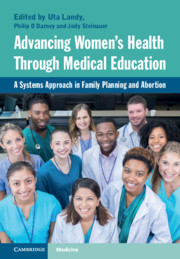 Advancing Women's Health Through Medical Education
Advancing Women's Health Through Medical Education Culture Change and Access to Care
from Section I - Abortion Training: Workforce, Leadership, Social & Political Impact
Published online by Cambridge University Press: 30 July 2021
The University of California, San Francisco (UCSF) became the first site for the Fellowship in Family Planning when Dr. Philip Darney enrolled Dr. Dilys Walker as a fellow in 1991. UCSF subsequently became home to two national programs: the national Family Planning Fellowship, founded to develop physician-leaders in reproductive health, and, soon after, in 1999, The Ryan Residency Programs, conceived by Dr. Uta Landy, a nation-wide initiative to integrate and enhance family planning training for obstetrics and gynecology residents. Now with 30 fellowship sites at leading US medical schools and over 100 Ryan Residency Programs, faculty, fellows, and residents provide family planning care and training, and conduct a broad range of family planning research. These two programs have led to improved clinical care, teaching, education, research and culture change in academic medicine and the field of family planning in the US and around the world.
To save this book to your Kindle, first ensure [email protected] is added to your Approved Personal Document E-mail List under your Personal Document Settings on the Manage Your Content and Devices page of your Amazon account. Then enter the ‘name’ part of your Kindle email address below. Find out more about saving to your Kindle.
Note you can select to save to either the @free.kindle.com or @kindle.com variations. ‘@free.kindle.com’ emails are free but can only be saved to your device when it is connected to wi-fi. ‘@kindle.com’ emails can be delivered even when you are not connected to wi-fi, but note that service fees apply.
Find out more about the Kindle Personal Document Service.
To save content items to your account, please confirm that you agree to abide by our usage policies. If this is the first time you use this feature, you will be asked to authorise Cambridge Core to connect with your account. Find out more about saving content to Dropbox.
To save content items to your account, please confirm that you agree to abide by our usage policies. If this is the first time you use this feature, you will be asked to authorise Cambridge Core to connect with your account. Find out more about saving content to Google Drive.